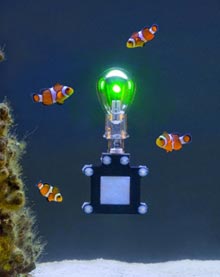 Waterproof lithium-air batteriesA California company's lithium metal-air batteries are lightweight and energy dense. Jun 26, 2009 - Katherine Bourzac - Technology Review A company based in Berkeley, CA, is developing lightweight, high-energy batteries that can use the surrounding air as a cathode. PolyPlus is partnering with a manufacturing firm to develop single-use lithium metal-air batteries for the government, and it expects these batteries to be on the market within a few years. The company also has rechargeable lithium metal-air batteries in the early stages of development that could eventually power electric vehicles that can go for longer in between charges.
Interest in lithium metal-air batteries has been growing in recent years, along with the demand for lighter power sources for devices ranging from plug-in hybrid vehicles to laptops. In lithium-ion batteries, the electrodes are made of materials such as graphite, while in a lithium-metal battery, the anode is made up entirely of lithium metal, and the surrounding air can act as the cathode. Lithium-metal batteries approach the energy density of fuel cells without the plumbing needed for these devices; in theory, the maximum energy density is more than 5,000 watt-hours per kilogram, or more than 10 times that of today's lithium-ion batteries. Lithium metal-air batteries are also very lightweight because it's not necessary to carry a second reactant. Lithium metal is "the holy-grail battery material," says Steven Visco, chief technical officer and founder of PolyPlus. IBM recently announced that it would develop lithium metal-air batteries for the energy grid and for transportation. "Lithium ion is the gold standard, but what can beat it is lithium metal," says Paul Beach, president of battery manufacturer Quallion of Sylmar, CA. Using lithium metal as a battery electrode, however, has proved problematic, mainly because the material reacts rapidly and violently with water. "People have thought about lithium-air batteries for decades, but there's always water in the air," says Visco. Exposure to even traces of water rapidly degrades the material.
|
Email this page to a friend
If you speak another language fluently and you liked this page, make
a contribution by translating
it! For additional translations check out FreeTranslation.com
(Voor vertaling van Engels tot Nederlands)
(For oversettelse fra Engelsk til Norsk)
(Для дополнительных
переводов проверяют
FreeTranslation.com )


